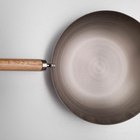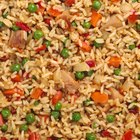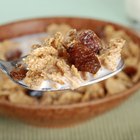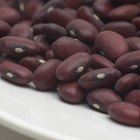
Stockbyte/Stockbyte/Getty Images
Pad ped is a Thai dish consisting of vegetables and sometimes meat stir-fried in a red curry, known as pad ped paste. While the ingredients vary, the basic recipe is healthy if eaten in moderation. The nutrients in pad ped paste are minimal, as it typically contributes about 15 calories, 3 grams of carbohydrates and 3 milligrams of sodium per tablespoon.
Basic Pad Ped Recipe
Place a deep skillet or a wok over medium-high heat and add about 2 tablespoons of water. The water is in place of oil to cut calories. When the water begins simmering, add one diced white onion and two diced garlic cloves. Stir them for about 3 minutes and add 1 cup of bamboo shoots, 1/4 cup of fresh Thai basil, 1/2 cup of snow peas and 3 minced kaffir lime leaves. Stir the contents of the skillet or wok for 5 minutes. Add 2 tablespoons of palm sugar, 2 cups of light coconut milk, 1 teaspoon of low-sodium soy sauce and 5 tablespoons of pad ped paste. Reduce the heat to medium-low and continue stirring the ingredients for about 10 minutes. Divide the pad ped into 3 portions and serve it while hot. Most of the required ingredients are available from Asian markets.
Calories, Carbohydrates and Protein
One serving of pad ped contains approximately 133 calories, 22 grams of carbohydrates and 3 grams of protein. That is just over 6 percent of 2,000 calories, a standard daily recommended intake, or DRI. One serving of pad ped makes up about 10 percent of a DRI of 225 grams of carbohydrates and 6 percent of a DRI of 50 grams of protein. For a single meal, these numbers are relatively low and fit easily into a healthy diet.
Fat, Saturated Fat and Sodium
A single serving of pad ped contains 7 grams of fat, 4 of which are saturated. That makes up about 7 percent of an average DRI of 44 grams of fat and 25 percent of a daily saturated fat limit of 16 grams. One serving of pad ped also contains a massive 1,297 milligrams of sodium. That is just over 56 percent of a healthy DRI of 2,300 milligrams of sodium. It is for this reason that you must eat pad ped in moderation, because just one extra helping would quickly send you over 2,300 milligrams of sodium.
Considerations
The exact brands and ingredients used in the pad ped dictate its nutritional value. For accurate numbers, add up the nutrients in each ingredient you use. Divide the totals by the number of servings to find the exact nutrition in each meal. Chicken, beef, pork, fish, tofu, eggplant and many other vegetables are commonly added to pad ped. In addition, it is often served over a bed of rice to absorb some of the sauce and lessen the spice of the curry. If you add any of these ingredients to your pad ped, do not forget to include their nutritional values in the total numbers. If you eat pad ped at a restaurant, ask for the nutritional value of the recipe and the serving size, because several variations exist.
Related Articles

The Ingredients in Triple Paste Diaper ...
Quick and Easy Pad Thai Recipe

How to Use Clearasil

How to Make Tortilla Soup

How to Make Easy 5 Ingredient Fresh ...
Tasty One-Pot Pad Thai Recipe

Calories in Peppermint Extract

Calories in a Subway Cheese Pizza

How to Make Sauce for Squid Balls

How to Cook Arroz Chaufa
Seafood Gumbo Calories

Calories in a Bowl of Raisin Bran Cereal

Proper Ratios on Mixed Drinks

How to Make the most Effective Homemade ...

Salt Water Taffy Nutritional Facts

Cetaphil Antibacterial Cleansing Bar ...

How to Cook Red Snapper Jamaican Style

How to Make Pancake Syrup From Karo ...

Calories in a Cup of Turkey Chili

Red Kidney Beans Nutrition
References
Writer Bio
Serena Styles is a Colorado-based writer who specializes in health, fitness and food. Speaking three languages and working on a fourth, Styles is pursuing a Bachelor's in Linguistics and preparing to travel the world. When Styles isn't writing, she can be found hiking, cooking or working as a certified nutritionist.
Photo Credits
Stockbyte/Stockbyte/Getty Images